|
|
|
Sort Order |
|
|
|
Items / Page
|
|
|
|
|
|
|
| Srl | Item |
| 1 |
ID:
132781
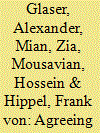

|
|
|
|
|
| Publication |
2014.
|
| Summary/Abstract |
Iran is negotiating with a group of six states over the future of its nuclear program. In November 2013, Iran and the P5+1 (China, France, Germany, Russia, the United Kingdom, and the United States) agreed to a Joint Plan of Action that seeks to reach a "comprehensive solution" by July 20, 2014.
The goal is an agreement on a set of measures that can provide reasonable assurance that Iran's nuclear program will be used only for peaceful purposes and enable the lifting of international sanctions imposed on Iran over the past decade because of proliferation concerns.
A key challenge is to reach agreement on limiting Iran's uranium-enrichment program, which is based on gas centrifuges, in a way that would enable Iran to meet what it sees as its future needs for low-enriched uranium (LEU) fuel for nuclear research and power reactors while forestalling the possibility that this program could be adapted to quickly produce highly enriched uranium at levels and in amounts suitable for use in nuclear weapons
|
|
|
|
|
|
|
|
|
|
|
|
|
|
|
|
| 2 |
ID:
142389


|
|
|
|
|
| Summary/Abstract |
The July 14 agreement between Iran and the six-country group known as the P5+1 established a set of important limitations and related transparency measures on Iran’s nuclear activities.
|
|
|
|
|
|
|
|
|
|
|
|
|
|
|
|
| 3 |
ID:
129104
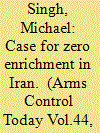

|
|
|
|
|
| Publication |
2014.
|
| Summary/Abstract |
In the debate over sanctions on Iran-their role in bringing Tehran to the negotiating table and their proper place in U.S. diplomatic strategy in the future-scant attention has been paid to a major shift in the negotiating position of the P5+1, the group of six countries (China, France, Germany, Russia, the United Kingdom, and the United States) that is negotiating with Tehran over the Iranian nuclear program. No longer is the P5+1 demanding that Iran halt uranium enrichment. Indeed, in the November 24 first-step nuclear accord, the Joint Plan of Action,[1] the P5+1 all but concedes that Iran will be permitted to enrich in perpetuity. In separate comments that have quickly become conventional wisdom among Iran analysts, U.S. negotiators now characterize their previous position that Iran should halt enrichment as "maximalist."[2] Although undoubtedly expedient, this shift away from a zero-enrichment negotiating position is misguided and unnecessary.[3] The U.S. shift away from zero enrichment to limited enrichment represents a significant diplomatic victory for Iran. For the last decade, the position of the EU-3 (France, Germany, and the UK) and then the P5+1 had been that Iran must "suspend all enrichment-related and reprocessing activities, including research and development." This position was enshrined as an Iranian obligation in a series of UN Security Council resolutions.[4] Iran, however, asserted a "right to enrich" and refused to halt enrichment after resuming it when nuclear talks with the European Union broke down in 2005. This difference formed the core of the confrontation that subsequently developed between Iran and the allies.
|
|
|
|
|
|
|
|
|
|
|
|
|
|
|
|
| 4 |
ID:
129103
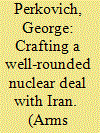

|
|
|
|
|
| Publication |
2014.
|
| Summary/Abstract |
A final nuclear deal with Iran should meet the underlying objective of the relevant UN Security Council resolutions since 2006: "the establishment of international confidence in the exclusively peaceful nature of Iran's nuclear programme."A final agreement could be codified and endorsed through a new resolution, which need not include all of the specific instrumental elements of past resolutions-for example, suspension of all uranium enrichment-if the council determines that the overall objective has been met. As the resolutions acknowledge, to be durable, such an agreement also must satisfy Iran's interest in having a purely peaceful nuclear program free from sanctions. The devilish challenge will be in the details. History will inform each party's requirements. The six-country group that has been negotiating with Iran, the so-called P5+1 (China, France, Germany, Russia, the United Kingdom, and the United States), will remember that Iran secretly had, at least until 2003, what appeared to be a dedicated, multifaceted program to acquire capabilities to produce nuclear weapons. Iran still has not cooperated fully with the International Atomic Energy Agency (IAEA) to clarify these activities and continues to expand sensitive fuel-cycle capabilities beyond any plausible civilian requirement. Iranian leaders, for their part, remember numerous episodes that reflect a U.S. determination to hasten an end to their regime.
|
|
|
|
|
|
|
|
|
|
|
|
|
|
|
|
| 5 |
ID:
115804
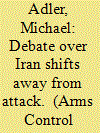

|
|
|
| 6 |
ID:
119771
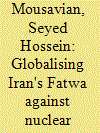

|
|
|
| 7 |
ID:
123545
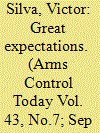

|
|
|
| 8 |
ID:
141314
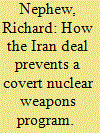

|
|
|
|
|
| Summary/Abstract |
On July 14, Iran and the six-country group known as the P5+1 (China, France, Germany, Russia, the United Kingdom, and the United States) reached an agreement on Iran’s nuclear program that promises to end the 13 years of escalating tensions that Tehran’s nuclear ambitions have caused.
|
|
|
|
|
|
|
|
|
|
|
|
|
|
|
|
| 9 |
ID:
141599
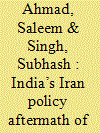

|
|
|
|
|
| Summary/Abstract |
After years of discussions and debates on whether Iran should be freed from restrictions and sanctions which had been imposed 12 years ago, the Islamic Republic finally got some relief when the P5+1 signed a nuclear deal with it. For Iran, it was like breaking down a wall that did not allow any progress in the country and crippled its economy. But the United States of America is still analyzing on whether what it did was right, and countries like Russia, China and India are rejoicing very much. On July 14, 2015, Iran and six world powers signed the agreement in exchange to limit its nuclear programme. The agreement allows for the country’s civil nuclear infrastructure to remain intact, sanctions against banks and exports to be lifted, and an arms embargo removed, to be replaced with five-year restrictions on arms-buying. However, in return, it has been clearly stated that “under no circumstances will Iran ever seek, develop or acquire any nuclear weapons”. For India, Iran’s nuclear deal will have some challenges and opportunities in its relations. Iran’s prolonged tussle with the West and the subsequent sanctions on its economy had been inconvenient for India.
|
|
|
|
|
|
|
|
|
|
|
|
|
|
|
|
| 10 |
ID:
139363
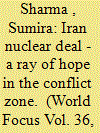

|
|
|
|
|
| Summary/Abstract |
Iran nuclear deal agreed in first week of April this year is a major breakthrough. After the long wait for almost 12 years, finally Iran agreed for accepting severely extensive inspection regime. No doubt, in bargain it got the promise from P5+1 i. e. U.S.A., U.K., Russia, France, China and Germany to lift all the sanctions imposed on it. On one hand deal is an initiative to end Iran’s isolation in world polity. On other, it marks an important step that world community has taken towards arms control in recent time. Of course all the details are yet to be finalized by the end of June. Nevertheless, it calls for an urgent need to enquire into the various aspects of this deal from the perspective of contemporary geo-politics.
|
|
|
|
|
|
|
|
|
|
|
|
|
|
|
|
| 11 |
ID:
133523
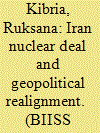

|
|
|
|
|
| Publication |
2014.
|
| Summary/Abstract |
The November 2013 interim nuclear deal that was signed between the P5+1 and Iran is an epochal event, though, given the volatile situation, it may be too early to make a correct prognosis of its ramifications. For one thing, the nuclear deal could complicate the regional security environment by exacerbating Saudi-Iranian tension, though as such, it is not the source. Regardless of Saudi displeasure at the conclusion of the accord, Iran's ascendancy is amply clear, with its ambiguous nuclear status playing a strategic role. While the dominant narrative currently is the centrality of Shia-Sunni regional tension represented by Iran and Saudi Arabia, reality is far more intricate and multi-dimensional, requiring a more nuanced appreciation of their relationship, which suggests that, for the foreseeable future it would be in the US interest to have Saudi Arabia, off-setting Iran, but from a much weaker position, in a replay of the game of balance of power achieved through sustained geopolitical manipulation, and a smaller American foot-print. The goal of Tehran's nuclear brinksmanship is essentially ensuring its regional primacy, which accords with US interests, too. While the recent interim Iran deal apparently concerns the nuclear issue, it has far-reaching implications for the global energy market, which the relaxation of economic sanctions and the integration of Iran as a legitimate member of the international community is certain to affect. US-Iran normalisation of relations is quietly enhancing China's role, both economic and military, in the Gulf region, whose energy resources for the foreseeable future would continue to remain crucial for Beijing. More than a reconciliation between Washington and Tehran, the essence of a real paradigm shift would involve a Saudi-Iranian accommodation, and de facto Saudi acceptance of Iran's regional pre-eminence.
|
|
|
|
|
|
|
|
|
|
|
|
|
|
|
|
| 12 |
ID:
111977
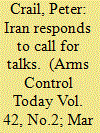

|
|
|
| 13 |
ID:
119002
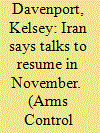

|
|
|
| 14 |
ID:
129108
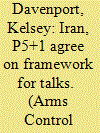

|
|
|
|
|
| Publication |
2014.
|
| Summary/Abstract |
After three days of talks in Vienna, Iran and six world powers agreed last month on a framework and timetable to guide the first four months of negotiations on a comprehensive deal on Iran's nuclear program. EU foreign policy chief Catherine Ashton, who leads the negotiating team for the six-country group known as the P5+1 (China, France, Germany, Russia, the United Kingdom, and the United States), said in a Feb. 20 statement that the parties had "identified all of the issues" to be addressed in the comprehensive agreement. An official who was briefed on the talks told Arms Control Today in a Feb. 20 e-mail that this is not a "written agenda" but an "understanding of the issues that must be covered." The official, who is from a P5+1 country, said that most of the discussions were on process but that "some substance was covered." The Feb. 18-20 meetings marked the resumption of political-level negotiations between Iran and the P5+1, following a Nov. 24 agreement on a plan of action, which laid out initial steps for each side to take and the broad parameters to guide negotiations on the comprehensive deal. (See ACT, December 2013.)
|
|
|
|
|
|
|
|
|
|
|
|
|
|
|
|
| 15 |
ID:
115745
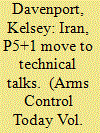

|
|
|
| 16 |
ID:
127560
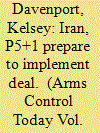

|
|
|
| 17 |
ID:
121692
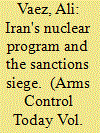

|
|
|
|
|
| Publication |
2013.
|
| Summary/Abstract |
The latest round of nuclear talks between Iran and the P5+1 (the five permanent members of the Security Council plus Germany) in the Kazakh city of Almaty yielded no results. The two sides remained poles apart.
|
|
|
|
|
|
|
|
|
|
|
|
|
|
|
|
| 18 |
ID:
143832
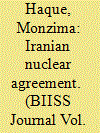

|
|
|
|
|
| Summary/Abstract |
Over the last two and a half years, negotiators from P5+1 and Iran are trying to reach out a diplomatic solution on the issue of nuclearisation of Iran. The motive behind such an arrangement had been to ensure that Iran’s nuclear ambition remains exclusively peaceful in harmony with the international non-proliferation principles. Iran too, wanted to break out from the shackles of sanctions that had limited its global commerce in the past years. With the conclusion of a nuclear agreement in Vienna, it is expected that Iran will not pursue actions to develop nuclear weapons, at least in the immediate future. Nevertheless, implementation of the agreement requires walking down an even more complicated path than negotiation and is considered to have significant implications for the Middle Eastern region. Given this context, this paper makes an attempt to review the nuclear deal being signed and looks into its future implications.
|
|
|
|
|
|
|
|
|
|
|
|
|
|
|
|
| 19 |
ID:
124237
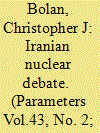

|
|
|
|
|
| Publication |
2013.
|
| Summary/Abstract |
Much of the public debate surrounding US policies regarding Iran has been distorted by myths that obscure the actual status of Iranian nuclear programs. Similarly, discussions about the implications of a nuclear-armed Iran are often built on questionable assumptions requiring more thorough examination. This article dispels these myths, questions these assumptions, and draws important implications for US policymakers in this critical strategic debate.
|
|
|
|
|
|
|
|
|
|
|
|
|
|
|
|
| 20 |
ID:
115743
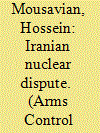

|
|
|
|
|
| Publication |
2012.
|
| Summary/Abstract |
After a pause of more than a year, the seven countries that are holding talks on Iran's nuclear program resumed their discussions in April, with subsequent meetings in May and June. As the countries- Iran and the P5+1 (China, France, Russia, the United Kingdom, and the United States)- prepare for their next meetings, efforts to find pathways to a resolution need to take into account the origins of Iran's nuclear program and the sources of the ongoing dispute over it.
|
|
|
|
|
|
|
|
|
|
|
|
|
|
|
|
|
|
|
|
|